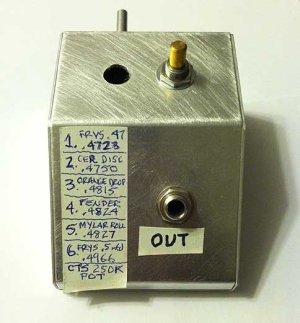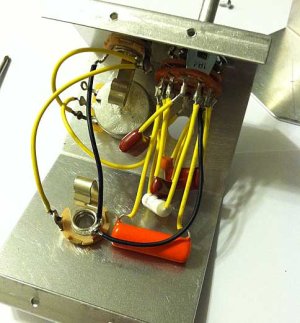I have a meter that measures capacitance. When the inexpensive ceramics were hooked up and left over a period of several minutes it never read a consistent value the entire time. All the other types (and I had the Vitamin Qs, Black Bees, Orange drops, etc.) all the others when left hooked up to the meter for several minutes or more read a stable value throughout the measuring period. Even generic electronic store brand mylar pills were stable. I tried at least 4 of each type of cap, sometimes 6 or more.
I did not disassemble, smash or reverse engineer any caps to determine root cause because the caps that were not performing were less than $1 each. It's not worth it to me to know. I think it's the manufacturers problem to figure out why they aren't working. As for me, I simply learned what I needed to know as far as
electronic performance - which is the lowest-end components were not electrically stable so I will not use them. But every other type and quality seemed to perform electronically the same.
I also measured all the caps I had and found one of each type that was within the tightest tolerance I could get, not more than 5% at the extreme. I wired them on a 6-way in a project box with a pot (making a normal tone control) and went from my pickup leads, straight to the box, to a couple different amps and played with each cap for a while to see if I noticed anything. Below is the last test box I made (I did this a couple times with different caps and setups - .47uf plus 250k pot, .22uf plus 500k pot, etc.)
View attachment 55924View attachment 55925
I also tried bridging each sample cap from the hot lead to ground straight off the pickup leads and to a cable straight into an amplifier I was familiar with, just to hear if there was any difference due to cap alone. I tried a couple different guitar amplifiers that I knew well so I could tell what the cap was contributing to the sound.
The only sonic difference in stable caps I could correlate was that higher values led to darker tone or lower corner frequency when the tone control was turned all the way down, or when the cap was bridged directly to ground. The inexpensive ceramics, however, caused some lack of clarity - when I played chords, the notes in the middle of the chord were noticeably 'blurry', muddy, indistinct - yet I could flip the switch and hear note definition through the dark tone with all the other caps. That's my experience. I couldn't find any other significant factors to correlate the problem to other than the inconsistent discharge of the cap.
If anyone thinks my method was not sound or scientific, I don't really care because I was not trying to answer the question for all mankind. I was just trying to learn enough to get my guitar to sound the way I need it when I need it, and on that front - mission accomplished. Anyone else is perfectly welcome to post their own experiment, experience and results, and even uncover flaws that I didn't discover.




